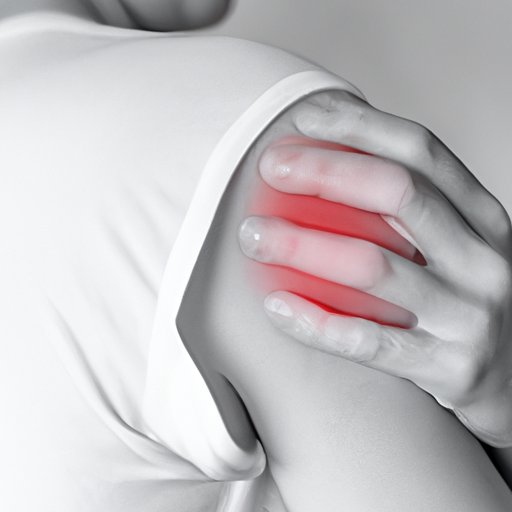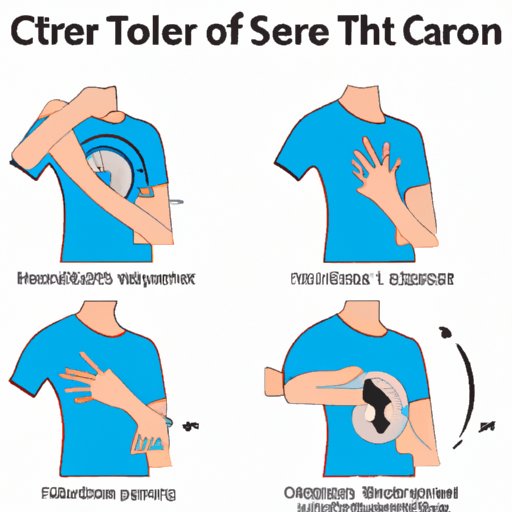
I. Introduction
A torn rotator cuff is a common injury that affects many people, especially those who engage in physical activities that require repetitive overhead arm motion. The rotator cuff is made up of four muscles in the shoulder joint that work together to stabilize and rotate the arm. A tear in the rotator cuff can cause significant pain and discomfort, and if left untreated, it can lead to long-term damage. Therefore, it is essential to identify the symptoms of a torn rotator cuff early so that you can seek proper medical attention and treatment.
II. How to Identify the Symptoms of a Torn Rotator Cuff: A Complete Guide
One of the challenges of identifying a torn rotator cuff is that the symptoms are not always obvious. In some cases, the pain may be mild and intermittent, while in others, it can be severe and constant. Here are some of the key symptoms to look for:
1. Pain in the Shoulder
Pain in the shoulder is one of the most common symptoms of a torn rotator cuff. The pain may be a dull ache or a sharp, stabbing sensation and may worsen when you move your arm. You may also experience pain when you rest your arm on your side or lay on your affected side.
2. Weakness in the Arm
A rotator cuff tear can cause weakness in the affected arm, making it difficult to lift or carry objects. You may also find it challenging to perform daily activities that require arm movement, such as brushing your hair or reaching up to a high shelf.
3. Limited Range of Motion
If you have a torn rotator cuff, you may experience a decrease in your arm’s range of motion. You may find it difficult to reach behind your back, rotate your arms, or lift your arms above your head. In severe cases, you may experience a complete loss of motion.
4. Clicking or Popping Sensation
Some people with a torn rotator cuff may experience a clicking or popping sensation in the shoulder joint when they move their arm. This may be due to the torn tendon catching on the shoulder joint as it moves.
5. Shoulder Stiffness
A torn rotator cuff can cause shoulder stiffness, especially in the morning or after long periods of inactivity. You may also experience muscle spasms or cramps in the affected arm.
If you have any of these symptoms, it is important to see a doctor for a proper diagnosis. A doctor can evaluate your condition and determine the best treatment plan for you, which may include rest and physical therapy, medication, or surgery.
III. Shoulder Pain: Understanding the Symptoms of a Torn Rotator Cuff
Shoulder pain is a common complaint, and there can be several reasons why you may experience it. It can be acute or chronic, dull or sharp, and can affect one or both shoulders. Understanding the different types of shoulder pain can help you identify if your symptoms are due to a torn rotator cuff.
1. Overview of Shoulder Pain
Shoulder pain is a general term used to describe any discomfort in the shoulder area. The shoulder joint is a complex structure that is made up of bones, muscles, ligaments, and tendons, and any one of these structures can be injured or inflamed, leading to pain.
2. Common Causes of Shoulder Pain
In addition to a torn rotator cuff, there are several other common causes of shoulder pain, including:
– Arthritis
– Bursitis
– Frozen shoulder
– Impingement syndrome
– Dislocated shoulder
If you are experiencing shoulder pain that is severe or lasts for more than a few days, it is essential to see a doctor to determine the underlying cause.
3. Difference between Normal Shoulder Pain and Pain Caused by a Torn Rotator Cuff
Normal shoulder pain is typically caused by muscle fatigue or overuse. It may feel sore or achy but is not usually accompanied by weakness or limited range of motion. Pain caused by a torn rotator cuff, on the other hand, is usually more severe and can be accompanied by other symptoms, such as weakness and limited range of motion.

IV. Five Key Signs Your Rotator Cuff Might Be Torn
Here are five of the most common symptoms of a torn rotator cuff:
1. Sudden, Intense Pain
A tear in the rotator cuff can cause sudden, intense pain in the shoulder that may worsen when you move your arm. The pain may be severe enough to wake you up at night.
2. Weakness in the Arm
Weakness in the affected arm is another common symptom of a torn rotator cuff. This weakness may make it difficult to lift or carry objects and can affect your ability to perform daily activities.
3. Limited Range of Motion
If you have a torn rotator cuff, you may experience a decrease in your arm’s range of motion. You may find it difficult to reach behind your back, rotate your arms, or lift your arms above your head.
4. Cracking or Popping Sound
Some people with a torn rotator cuff may hear a cracking or popping sound when they move their arm. This sound may be due to the torn tendon catching on the shoulder joint as it moves.
5. Shoulder Stiffness
A torn rotator cuff can cause shoulder stiffness, especially in the morning or after long periods of inactivity. You may also experience muscle spasms or cramps in the affected arm.
V. When Your Shoulder Just Won’t Stop Hurting: Signs of a Torn Rotator Cuff
If you have a torn rotator cuff, you may experience chronic pain that persists despite treatment and rest. Chronic pain can be debilitating and affect your quality of life. Here are some tips for managing chronic pain caused by a torn rotator cuff:
– Use pain relievers as directed by your doctor
– Apply heat or ice to the affected area to help reduce pain and inflammation
– Rest your shoulder and avoid activities that aggravate your symptoms
– Participate in physical therapy to help improve range of motion and strength
– Consider alternative therapies, such as massage or acupuncture, to help manage your pain.
If your symptoms persist despite these efforts, it is important to seek medical treatment. Your doctor may recommend surgery or other advanced treatments to relieve your chronic pain and improve your quality of life.
VI. The Top Symptoms of a Torn Rotator Cuff You Need to Know About
Here is a summary of the most common symptoms of a torn rotator cuff:
– Shoulder pain
– Weakness in the affected arm
– Limited range of motion
– Clicking or popping sensation
– Shoulder stiffness
Early detection and treatment of a torn rotator cuff are essential for a successful outcome. If you notice any of these symptoms, it is important to see a doctor as soon as possible for a proper evaluation and treatment plan.
VII. A Quick Guide to Recognizing Rotator Cuff Tear Symptoms
To help you recognize the symptoms of a torn rotator cuff, here is a quick guide:
– Look for shoulder pain that may worsen when you move your arm
– Check for weakness in the affected arm that may make it difficult to lift or carry objects
– Observe if you have a limited range of motion and difficulty performing daily activities
– Listen for a cracking or popping sound when you move your arm
– Check for shoulder stiffness, especially in the morning or after long periods of inactivity
If you experience any of these symptoms, it is important to see a doctor for further evaluation and treatment.
VIII. Shoulder Injury Alert: Watch for These Common Symptoms in a Torn Rotator Cuff
A torn rotator cuff can be caused by a variety of factors, including age, repetitive overhead arm motion, and traumatic injury. Here are some tips for preventing injury:
– Strengthen your shoulder muscles through exercises and weight training
– Use proper form when performing overhead activities
– Avoid repetitive shoulder motion if possible
– Take breaks and stretch your arms and shoulders regularly during prolonged activities (such as painting or gardening)
– Wear appropriate protective gear during physical activities, such as shoulder pads or elbow pads.
It is also important to be aware of the common symptoms of a torn rotator cuff, including shoulder pain, weakness in the arm, limited range of motion, cracking or popping sound, and shoulder stiffness.
IX. Conclusion
A torn rotator cuff can cause significant pain and discomfort, making it difficult to perform daily activities and affecting your quality of life. It is important to identify the symptoms of a torn rotator cuff early and seek proper medical treatment. By taking care of your shoulders and preventing injury, you can reduce your risk of developing a torn rotator cuff and other shoulder issues. Remember to seek medical attention if you experience any symptoms, as early detection and treatment are key to a successful outcome.





